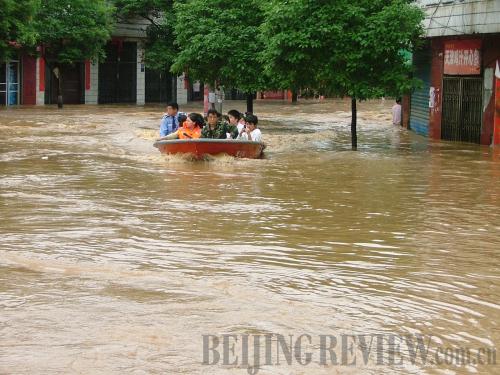|
 |
|
AGAINST ALL ODDS: Students attending the national college entrance examinations in Xupu County of Hunan Province take boats guarded by soldiers to their exam rooms (WANG JIYUN) |
Experts say the southern part of the Huaihe River in central China has entered its major flood season, and the northern part of the country will follow suit.
At the outset of the flood season, the middle and lower reaches of the Yangtze River in south China took in more water from the upper reaches than previous years. Meanwhile, the water level at Yangtze River is 1 meter higher than average.
To date, more than 110 rivers have risen above their alert levels. Zhang said it's likely the major rivers of south China will swell to cause massive flooding if the storms continue.
The southwestern part of China suffered from a severe 200-day drought ending in April. The dry weather frizzled the soil, which became less viscous. The stones cracked. After such a long drought, soil and stones can easily be washed away, leading to disastrous mudflows.
Old infrastructure
Ever since the founding of the People's Republic of China in 1949, the central and local governments have been striving to build up a concrete fortress to guard against floods and droughts that frequently visit the country.
Huge dams have been built alongside major riverbanks. However, flood control projects in medium- and small-sized rivers are far from sufficient, especially for defense against landslides and mudflows, said Zhang.
Making things worse is a lot of people in rural areas live along mountainsides or at the foot of mountains. Landslides can easily destroy their property no matter how rarely they occur.
The recent floods in cities in the south have also threatened the aging drainage system.
"It seems to me that our country has been coping with floods every year, but why are we having the same problems year after year?" said Xu Qing, a Guangzhou resident, adding "you cannot blame global warming all the time."
"When it comes to floods, people will immediately think of rural and mountainous areas while ignoring the potential damages it might cause to cities," said Shan Chunchang, head of the State Council emergency management expert group at a recent forum on the future of the city.
Guangzhou City, capital of Guangdong, the economic powerhouse of south China, was flooded twice in May. More than 13,000 cars were submerged resulting in more than 100 million yuan ($14.6 million) in insurance claims, Nanfang Daily reported. Underground garages were the hardest hit. In other cities cars, homes and shops were also consumed by floodwaters.
Shan questioned the drainage systems in cities and said they have invested too much aboveground and too little underground.
"All architecture must have emergency entrances and exits for when floods occur," said Ni Yang, Deputy Dean of the Architectural Design Research Institute of the South China University of Technology.
Ni said many domestic architects lack the experience in designing structures that can cope with natural disasters. Unlike foreign parking lots, many Guangzhou garages do not have drainpipes or water pumps installed.
Zhou Yuwen, professor at the Beijing University of Technology and a drainage system expert, said the urban areas are getting larger and gradually taking up rivers and wetlands, which can absorb more water. "The permeable soil has been replaced by concrete," said Zhou.
According to experts, the more prosperous the city becomes, the more it must invest in underground infrastructure like its drainage system. Economic achievements must go side by side with advances in infrastructure. | 